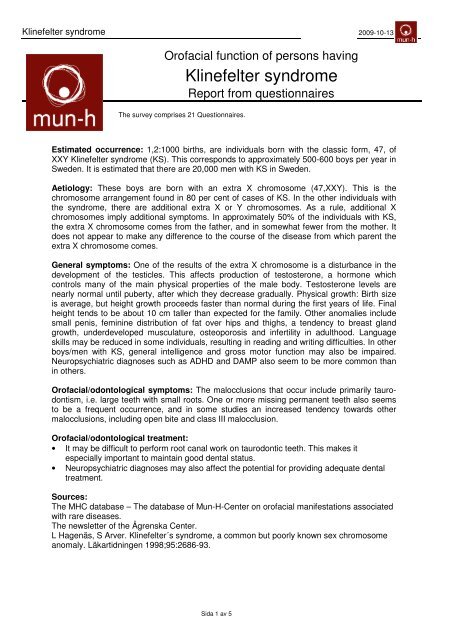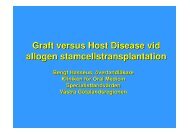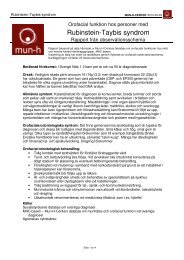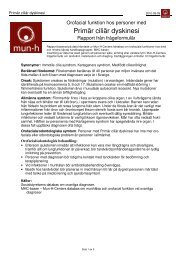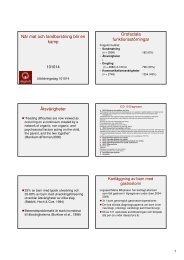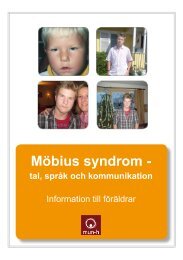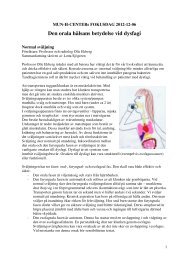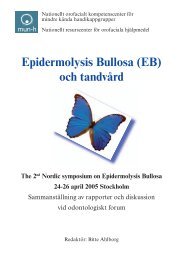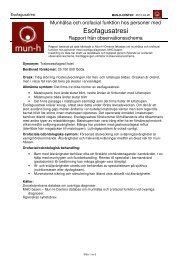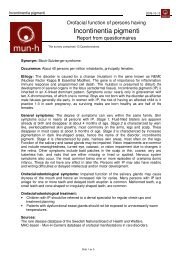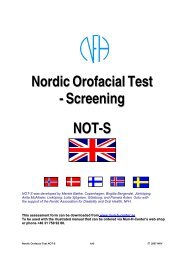Klinefelter syndrome - Mun-H-Center
Klinefelter syndrome - Mun-H-Center
Klinefelter syndrome - Mun-H-Center
You also want an ePaper? Increase the reach of your titles
YUMPU automatically turns print PDFs into web optimized ePapers that Google loves.
<strong>Klinefelter</strong> <strong>syndrome</strong> 2009-10-13<br />
Orofacial function of persons having<br />
<strong>Klinefelter</strong> <strong>syndrome</strong><br />
Report from questionnaires<br />
The survey comprises 21 Questionnaires.<br />
Estimated occurrence: 1,2:1000 births, are individuals born with the classic form, 47, of<br />
XXY <strong>Klinefelter</strong> <strong>syndrome</strong> (KS). This corresponds to approximately 500-600 boys per year in<br />
Sweden. It is estimated that there are 20,000 men with KS in Sweden.<br />
Aetiology: These boys are born with an extra X chromosome (47,XXY). This is the<br />
chromosome arrangement found in 80 per cent of cases of KS. In the other individuals with<br />
the <strong>syndrome</strong>, there are additional extra X or Y chromosomes. As a rule, additional X<br />
chromosomes imply additional symptoms. In approximately 50% of the individuals with KS,<br />
the extra X chromosome comes from the father, and in somewhat fewer from the mother. It<br />
does not appear to make any difference to the course of the disease from which parent the<br />
extra X chromosome comes.<br />
General symptoms: One of the results of the extra X chromosome is a disturbance in the<br />
development of the testicles. This affects production of testosterone, a hormone which<br />
controls many of the main physical properties of the male body. Testosterone levels are<br />
nearly normal until puberty, after which they decrease gradually. Physical growth: Birth size<br />
is average, but height growth proceeds faster than normal during the first years of life. Final<br />
height tends to be about 10 cm taller than expected for the family. Other anomalies include<br />
small penis, feminine distribution of fat over hips and thighs, a tendency to breast gland<br />
growth, underdeveloped musculature, osteoporosis and infertility in adulthood. Language<br />
skills may be reduced in some individuals, resulting in reading and writing difficulties. In other<br />
boys/men with KS, general intelligence and gross motor function may also be impaired.<br />
Neuropsychiatric diagnoses such as ADHD and DAMP also seem to be more common than<br />
in others.<br />
Orofacial/odontological symptoms: The malocclusions that occur include primarily taurodontism,<br />
i.e. large teeth with small roots. One or more missing permanent teeth also seems<br />
to be a frequent occurrence, and in some studies an increased tendency towards other<br />
malocclusions, including open bite and class III malocclusion.<br />
Orofacial/odontological treatment:<br />
• It may be difficult to perform root canal work on taurodontic teeth. This makes it<br />
especially important to maintain good dental status.<br />
• Neuropsychiatric diagnoses may also affect the potential for providing adequate dental<br />
treatment.<br />
Sources:<br />
The MHC database – The database of <strong>Mun</strong>-H-<strong>Center</strong> on orofacial manifestations associated<br />
with rare diseases.<br />
The newsletter of the Ågrenska <strong>Center</strong>.<br />
L Hagenäs, S Arver. <strong>Klinefelter</strong>´s <strong>syndrome</strong>, a common but poorly known sex chromosome<br />
anomaly. Läkartidningen 1998;95:2686-93.<br />
Sida 1 av 5
<strong>Klinefelter</strong> <strong>syndrome</strong> 2009-10-13<br />
6<br />
3<br />
Age distribution<br />
2<br />
0- 2 3- 6 7- 9 10-12 13-15 16-18 19-29 30-<br />
Impaired vision<br />
7<br />
2<br />
0<br />
1<br />
1<br />
General disabilities<br />
Slight<br />
Moderate<br />
Severe<br />
Impaired hearing<br />
Slight<br />
Moderate<br />
Severe<br />
Behavioural deviation<br />
Slight<br />
Moderate<br />
Severe<br />
Epilepsy<br />
Slight<br />
Moderate<br />
Severe<br />
Retardation<br />
Slight<br />
Moderate<br />
Severe<br />
Mobility dysfunction<br />
Arm/hand<br />
Leg<br />
Wheel chair<br />
Walks with support<br />
Poor sitting balance<br />
Other<br />
Difficulty in communicating<br />
No speech<br />
Incomprehensible speech<br />
Alternative communication<br />
Communication aid<br />
0<br />
0<br />
0<br />
0<br />
0<br />
0<br />
0<br />
0<br />
0<br />
0<br />
1<br />
1<br />
2<br />
2<br />
2<br />
3<br />
3<br />
3<br />
4<br />
4<br />
4<br />
5<br />
5<br />
6<br />
7<br />
F<br />
M<br />
8<br />
8<br />
9<br />
10<br />
Number: 21<br />
Ages: 4 -- 19 years<br />
Sex: M (21) + F (0)<br />
12<br />
0 5 10 15 20 25<br />
Sida 2 av 5<br />
19<br />
18<br />
17<br />
15<br />
17<br />
19<br />
15
<strong>Klinefelter</strong> <strong>syndrome</strong> 2009-10-13<br />
10<br />
5<br />
About dental health - problems Oral <strong>Mun</strong>hälsa health<br />
0<br />
1<br />
1<br />
2<br />
3<br />
4<br />
4<br />
4<br />
5<br />
6<br />
7<br />
0 10 20 30<br />
0<br />
0 10 20 30 40 50 60<br />
10<br />
5<br />
Cavities in teeth<br />
Bleeding gums<br />
Loosening of the teeth<br />
Sores in mucous membrane<br />
Bad breath<br />
Faulty dentition<br />
Damaged teeth (accident)<br />
Pain in mouth<br />
Sleeps with open mouth<br />
Snoring<br />
Grinds his/her teeth<br />
How does NN experience the dental care received?<br />
0=no problems/10=great problems<br />
n=19<br />
How does NN manage to brush his/her teeth?<br />
0=well/10=not at all<br />
0<br />
0 10 20 30 40 50 60<br />
About dental health<br />
n=20<br />
20<br />
19<br />
18<br />
19<br />
18<br />
17<br />
18<br />
18<br />
19<br />
18<br />
18<br />
10 0<br />
10<br />
Excellent<br />
Fairly good<br />
Bad<br />
Has Har NN NN received fått tandregleringsbehandling?<br />
orthodontic treatment?<br />
10<br />
5<br />
16<br />
5<br />
Yes<br />
No<br />
0<br />
0 10 20 30 40 50 60<br />
10<br />
5<br />
NN is considered to be in need of orthodontic<br />
treatment<br />
0=no need/10=great need<br />
Age Age<br />
n=18<br />
If help is needed with brushing teeth, how does it<br />
proceed?<br />
0=no problems/10=great problems<br />
n=17<br />
0<br />
0 10 20 30 40 50 60<br />
Age Age<br />
Sida 3 av 5
<strong>Klinefelter</strong> <strong>syndrome</strong> 2009-10-13<br />
10<br />
5<br />
0<br />
0 10 20 30<br />
Age<br />
40 50 60<br />
10<br />
5<br />
0<br />
0 10 20 30<br />
Age<br />
40 50 60<br />
10<br />
5<br />
0<br />
0 10 20 30<br />
Age<br />
40 50 60<br />
10<br />
5<br />
Is it possible to eat?<br />
0=no problems/10=extreme problems<br />
Is it possible to drink?<br />
0=no problems/10=extreme problems<br />
Is it possible to suck?<br />
0=no problems/10=extreme problems<br />
Is it possible to swallow?<br />
0=no problems/10=extreme problems<br />
0<br />
0 10 20 30<br />
Age<br />
40 50 60<br />
About eating habits<br />
n=21<br />
n=21<br />
n=21<br />
n=21<br />
About eating habits - problems<br />
Takes long time to swallow bites of<br />
food<br />
Swallows large pieces<br />
Has difficulty in getting food off<br />
spoon<br />
Food/liquids leak out of corners of<br />
mouth<br />
Has difficulty in opening mouth/jaws<br />
Sensitive in mouth<br />
Vomits often<br />
Refuses to eat<br />
Breast feeding problems as infant<br />
Sida 4 av 5<br />
Often chokes on food<br />
Coughs when receiving liquid<br />
Food/liquid goes up the nose<br />
Food gets stuck in palate<br />
Presses tongue forward when<br />
swallowing<br />
Eats meat, hard bread etc.<br />
Eats coarsly mashed food<br />
Eats strained food<br />
Only liquid food<br />
Tube feeding<br />
Parenteral nutrition<br />
Does not receive enough nutrition<br />
Eats too much<br />
Can eat by himself/herself<br />
Can eat by himself/herself to a<br />
certain degree<br />
Is always feed<br />
Allergy to certain foods<br />
0<br />
0<br />
0<br />
0<br />
0<br />
0<br />
0<br />
0<br />
0<br />
0<br />
0<br />
1<br />
1<br />
1<br />
1<br />
1<br />
1<br />
1<br />
2<br />
2<br />
2<br />
2<br />
2<br />
0 10 20 30<br />
Food habits<br />
Special diet<br />
2<br />
2<br />
21<br />
20<br />
0 10 20 30<br />
20<br />
20<br />
21<br />
21<br />
21<br />
21<br />
21<br />
20<br />
21<br />
21<br />
21<br />
21<br />
21<br />
20<br />
21<br />
21<br />
21<br />
21<br />
21<br />
21<br />
21<br />
21<br />
21<br />
21<br />
21<br />
21<br />
21
<strong>Klinefelter</strong> <strong>syndrome</strong> 2009-10-13<br />
10<br />
5<br />
Drooling<br />
Drooling<br />
Slight<br />
Moderate<br />
Profusive<br />
Very profusive<br />
Performed drooling treatment<br />
0<br />
1<br />
1<br />
2<br />
2<br />
4<br />
N=20<br />
0 10 20 30<br />
How does parent/attendant experience the drooling?<br />
0=no problem/10=serious problem<br />
0<br />
0 10 20 30 40 50 60<br />
Age<br />
About drooling<br />
n=4<br />
Sida 5 av 5<br />
10<br />
5<br />
0<br />
0 10 20 30 40 50 60<br />
10<br />
5<br />
How does NN experience his/her drooling?<br />
0=no problem/10=serious problem<br />
Age<br />
How do people around NN experience the drooling?<br />
0=no problem/10=serious problem<br />
n=4<br />
n=4<br />
0<br />
0 10 20 30 40 50 60<br />
Age


